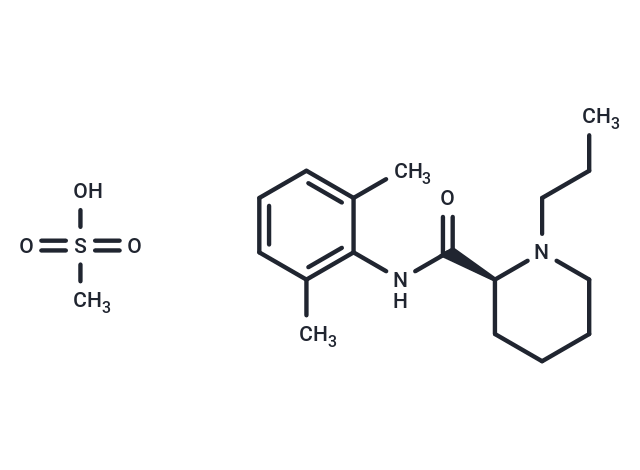Shopping Cart
Remove All Your shopping cart is currently empty
Your shopping cart is currently empty
Ropivacaine mesylate, a long-acting amide local anaesthetic, is used for spinal block and effectively mitigates neuropathic pain. It achieves analgesia by reversibly inhibiting sodium ion influx in nerve fibers, thus blocking impulse conduction. Additionally, Ropivacaine acts as an inhibitor of the K2P (two-pore domain potassium channel) TREK-1, exhibiting an IC50 of 402.7 μM in COS-7 cell membranes.


| Description | Ropivacaine mesylate, a long-acting amide local anaesthetic, is used for spinal block and effectively mitigates neuropathic pain. It achieves analgesia by reversibly inhibiting sodium ion influx in nerve fibers, thus blocking impulse conduction. Additionally, Ropivacaine acts as an inhibitor of the K2P (two-pore domain potassium channel) TREK-1, exhibiting an IC50 of 402.7 μM in COS-7 cell membranes. |
| In vivo | Epidural administration of Ropivacaine mesylate effectively mitigates neuropathic pain, including mechanical allodynia and heat hyperalgesia, without inducing analgesic tolerance, and delays neuropathic pain onset after peripheral nerve damage. It restrains pressure-induced increases in the filtration coefficient without altering pulmonary artery pressure, capillary pressure, or zonal characteristics, and prevents pressure-induced lung edema, hyperpermeability, and maintains normal oxygen levels, lung moisture balance, and plasma volume similar to control (sham) rats. Additionally, it reduces pressure-stimulated nitric oxide production, evidenced by lower nitro-tyrosine levels in the lungs compared to hypertensive conditions. The study used adult Sprague-Dawley rats, with a dosage of 1 μM Ropivacaine mesylate delivered via infusion into the perfusate reservoir, demonstrating its ability to attenuate pressure-related increases in the filtration coefficient. |
| Molecular Weight | 370.51 |
| Formula | C18H30N2O4S |
| Cas No. | 854056-07-8 |
| Smiles | CS(O)(=O)=O.CCCN1CCCC[C@H]1C(=O)Nc1c(C)cccc1C |
| Storage | Powder: -20°C for 3 years | In solvent: -80°C for 1 year | Shipping with blue ice/Shipping at ambient temperature. |
| Size | Quantity | Unit Price | Amount | Operation |
|---|

Copyright © 2015-2026 TargetMol Chemicals Inc. All Rights Reserved.